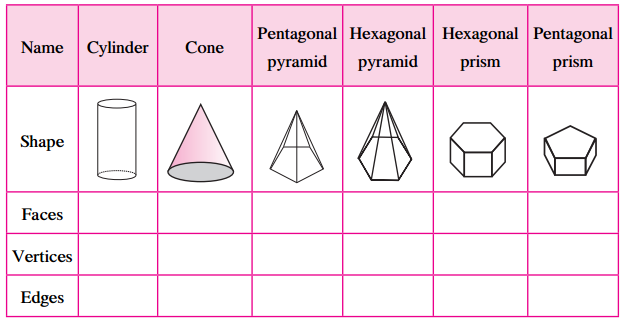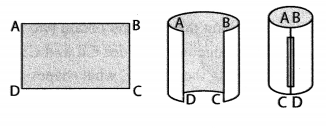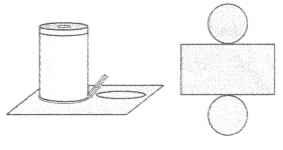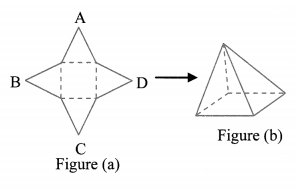Question 1.
Write the number of faces, edges and vertices of each shape in the table.
Solution:
| Name | Cylinder | Cone | Pentagonal pyramid | Hexagonal pyramid | Hexagonal prism | Pentagonal prism |
| Faces | 3 (2 flat + 1 curved) | 2 (1 flat + 1 curved) | 6 (5 triangles + 1 pentagon) | 7 (6 triangles + 1 hexagon) | 8 (6 rectangles + 2 hexagons) | 7 (5 rectangles + 2 pentagons) |
| Vertices | 0 | 1 | 6 | 7 | 12 | 10 |
| Edges | 2 (circular) | 1 (circular) | 10 | 12 | 18 | 15 |
Questions and Activities
Question 1.
- Take a rectangular sheet.
- Bring together its opposite sides. What shape does it form? (Textbook pg. no. 94)

Solution:
It forms a hollow cylinder.
Question 2.
- Take a cylindrical tin.
- Take a rectangular sheet with one side equal to the height of the tin.
- Wrap it around the tin to cover it completely and cut away the extra paper.
- Then unfold it and spread it out on a table.
- Take another sheet. Place the tin on it and draw its circular outline.
- Cut away the paper around it. Cut out another circle like this one.
- Place these discs next to the rectangular paper as shown in the given figure. Which figure is obtained? (Textbook pg. no. 94)

Solution:
The figure obtained is the net of the closed cylinder.
Question 3.
Can you tell? (Textbook pg. no. 95)
When playing carom, you make a pile of the pieces as shown in the picture. What is the shape of this pile?
If you place a number of CD’s or round biscuits one on top of the other, what shape do you get?
Solution:
In all the cases, it will form a cylindrical shape (2 circular faces and 1 curved surface).
Question 4.
- Draw a net as shown in figure (a) on a card sheet and cut it out.
- Fold along the dotted lines of the square and bring the sides together so that the vertices A, B, C and D meet at a point.
What shape does it form? (Textbook pg. no. 95)
Solution:
The given net forms a quadrangular pyramid.
Question 5.
- Draw a net as shown in figure (a) on a card sheet and cut it out.
- Fold along the dotted lines of the triangle and bring the sides together so that the vertices A, B and C meet at a point.
What shape does it form? (Textbook pg. no. 95)
Solution:
The given net forms a triangular pyramid.
Question 6.
- Using a compass draw a circle with centre C on a paper.
- Draw two radii CR and CS.
- Cut out the circle.
- Cut along the radii and obtain two pieces of the circle.
- Bring together the sides CR and CS of each piece.
On completing the activity, what shapes did you get? (Textbook pg. no. 95)
Solution:
On completing the activity, we get an open cone.
